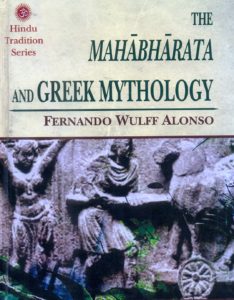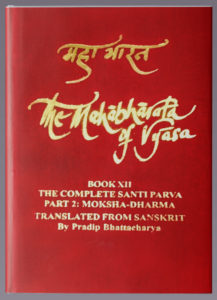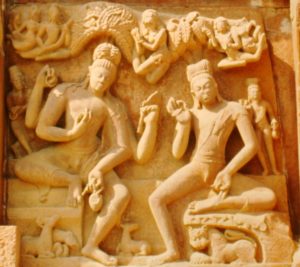Fernando Wulff Alonso: Mahabharata and Greek Mythology, translated by Andrew Morrow, ed. Alf Hiltebeitel, Motilal Banarsidass, 523 pages, Rs. 1495/-
The Sir Asutosh Mukherjee collection in the National Library contains a rare book  by an East India Company officer arguing that the Ramayana story was strongly influenced by the Iliad. Other than Megasthenes’ references to Indians carrying banners of Heracles and worshipping Dionysus, the Greek scholar Dios Chrysostom (40-120 AD) mentions translations of the Iliad in India. The Roman Claudius Aelianus (175-235 AD) reiterated this (e.g. the Trojan horse becoming Bhasa’s wooden elephant in Pratigya Yaugandharayana). In 1871 A.F.Weber, refuting M.H.Fauche’s proposition (supported by A.Lillie in 1912) that Homer had used the Ramayana as a guide, claimed that it was merely Buddhist legends grafted on to borrowings from Homer, an argument that W.T.Telang vigorously refuted. Weber cited Odysseus’ archery feat to win Penelope as having influenced the archery contests of Rama and Arjuna, ignoring that Rama breaks the bow and Arjuna does not shoot rivals dead. J.Lallemant argued in 1959 that the Mahabharata (MBH) influenced the Aeneid. In 1961 G.Duckworth argued that Turnus’ portrayal was based upon Duryodhana. In 1968 G.Dumezil put forward his theory of an Indo-European tri-functional ideology illustrated by the Pandavas (the dharma-king, the warrior, the grooms). Now, a Spanish professor in the University of Malaga has built up a strong case that the Homeric cycle and other Greek myths were adapted for the MBH.
by an East India Company officer arguing that the Ramayana story was strongly influenced by the Iliad. Other than Megasthenes’ references to Indians carrying banners of Heracles and worshipping Dionysus, the Greek scholar Dios Chrysostom (40-120 AD) mentions translations of the Iliad in India. The Roman Claudius Aelianus (175-235 AD) reiterated this (e.g. the Trojan horse becoming Bhasa’s wooden elephant in Pratigya Yaugandharayana). In 1871 A.F.Weber, refuting M.H.Fauche’s proposition (supported by A.Lillie in 1912) that Homer had used the Ramayana as a guide, claimed that it was merely Buddhist legends grafted on to borrowings from Homer, an argument that W.T.Telang vigorously refuted. Weber cited Odysseus’ archery feat to win Penelope as having influenced the archery contests of Rama and Arjuna, ignoring that Rama breaks the bow and Arjuna does not shoot rivals dead. J.Lallemant argued in 1959 that the Mahabharata (MBH) influenced the Aeneid. In 1961 G.Duckworth argued that Turnus’ portrayal was based upon Duryodhana. In 1968 G.Dumezil put forward his theory of an Indo-European tri-functional ideology illustrated by the Pandavas (the dharma-king, the warrior, the grooms). Now, a Spanish professor in the University of Malaga has built up a strong case that the Homeric cycle and other Greek myths were adapted for the MBH.
Alonso’s proposes that, following the Greek invasion, the MBH composers used “an extensive index of Hellenistic materials” systematically, beginning with the Iliad’s framework of the massacre of heroes willed by gods. He brushes aside N.J.Allen’s suggestion that the similarities between Arjuna and Odysseus stem from an older Indo-European narrative tradition, yet cites over 40 close parallels in the archery contests for Draupadi and Penelope that suggest a common Indo-European paradigm.
Alonso sees the MBH embodying the formation of post-Vedic “Hinduism” as a reaction against Buddhism and Jainism, propagating Krisnaite worship (he overlooks Shiva). The “discovery” of Brahmi script in Ashoka’s time is a watershed in the oral Vedic tradition, with Vyasa-the-Arranger editing the Vedas into a final form. Bechert and Von Simon have situated the development of Sanskrit in c. 2nd century BC. This is also when sculpted images appear. The Greco-Roman world was interacting with India at least since the time of Darius-I. Ashoka’s Edict XIII mentions embassies to Syria, Egypt, Macedonia, Cyrene and Epirus. Bilingual (Greek and Aramaic) and Greek Edicts exist. “Yavana” signifies all Mediterranean people. The MBH mentions Rome in the Sabha Parva, and Roman coins have been found at several archaeological sites. Philostratus (early 3rd century AD) in his Life of Apollonius of Tyana writes of a voyage to India for philosophical debate. Yavanajataka, Romakasiddhanta prove the Greco-Roman influence on astrology. Terms like “yavanika” show the influence of Greek drama. A Greek inscription in Kandahar authored by an Indian name (Sophitos son of Naratos) uses the opening verses of the Odyssey for his own woeful adventures.
Alonso finds as many as 97 major points of interconnection between Greek myth and the MBH. In both the gods plan the holocaust of power-drunk rulers to relieve the earth’s burden and usher in a new age—that of the audience. Losses are exceptionally heavy on both sides from the very young to the ancient. However, Alonso ignores a major difference. In Homer and Hesiod, Zeus manipulates the gods to shift the balance of battle daily. In Vyasa, the gods do not intervene during the war. Krishna, the devious avatar, makes the decisive moves and engineers a massacre of his own too. Long before the Trojan War, Zeus destroyed almost all mankind by a flood (cf. Gilgamesh, Genesis). Before Kurukshetra, Kshatriyas were annihilated in 21 battles in the previous yuga by another avatar, Parashurama. The Theban War in which Diomedes and Sthenelus fought precedes the Trojan War. Similarly, the Kurukshetra fratricide precedes the internecine massacre at Prabhasa.
Alonso quotes (p. 158) Sanjaya speaking to Dhritarashtra of the gods driving a person mad first, whom they wish to defeat (Sabha Parva, section 72), which could as well have been spoken by Agamemnon. Parallel to gods espousing opposing camps in Homer we have in Vyasa the devas incarnating as the Pandavas, Krishna and their allies, while the Asuras take possession of Kaurava heroes who are simultaneously incarnations of deities. As Zeus favours now one side then the other in battle, so Shiva empowers both Arjuna and Asvatthama, is responsible for the births of Draupadi, Shikhandi, Gandhari’s 100 sons, and has five Indras reborn as the Pandavas. The avatar Parashurama gives weapons to the Kaurava heroes Bhishma, Drona and Karna. Homeric and Vyasan gods provide opponents with special armour and weapons.
In both epics, heroes are born of intercourse between devas and humans. But unlike Zeus, Indra plays no major role other than depriving Karna of his divine armour and earrings and gifting him the infallible missile. Alonso argues that Zeus’ role, and Athena’s, are paralleled by Krishna as “supernatural authority.” However, as Bankim Chatterjee showed, in the epic Krishna is overwhelmingly human, except in interpolated miraculous episodes. Further, there is no parallel in Homer to the “supernatural authority” being killed by a petty hunter. In both, exiled heroes gain allies through marriage, peace embassies fail and fratricidal war results.
A mighty female figure of supernatural birth is the cause of the wars: Helen, Zeus’ sole mortal daughter and fire-born Draupadi. Opposing them are half-god Achilles and Vasu-incarnate Bhishma. Just as Paris gazes on three naked goddesses with hubris, so does Mahabhisha on Ganga as the breeze uplifts her dress. Both face tragic consequences. Thetis, mother of Achilles, and Ganga, mother of Bhishma, are water goddesses who leave their husbands after delivering the hero and being stopped by the mortal spouse from drowning the child. Aeneas, son of Aphrodite and Anchises is taken away at birth and returned later like Achilles and Bhishma. Neither hero marries; both are the chief warriors of their armies, but subject to lesser mortals who are kings. The refusals of both exacerbate the war. Moreover, Karna abstains from fighting like Achilles. After a victory in daytime, Achilles and Bhishma receive a clandestine visitor at night from the opposite camp accompanied by a god (Hermes with Priam, Krishna with the Pandavas). The visit occurs at the end of the ninth year/ninth day. Both die in the tenth year/day. Just as Apollo stands behind Paris guiding his arrow to kill Achilles, so Arjuna shoots from behind Shikhandi to fell Bhishma. Both heroes are overshadowed by an awareness of their tragic destiny. Ganga’s lament at Bhishma’s death has exact parallels in the Iliad.
Both Agamemnon and Duryodhana insult their generals, defy supernatural powers and violate princesses (Briseis, Draupadi). In both cases, what the first messenger says is very similar and a god (Athena, Krishna) intervenes invisibly after interjection by an elder (Nestor, Vidura) fails. The commanders-in-chief of the victors (Agamemnon and Dhrishtadyumna) are murdered soon after victory, defenceless (drowned, suffocated). Both are closely linked to the heroine (Helen, Draupadi). Their fathers lose the kingdom to a brother (Atreus to Thyestes) or a close friend (Drupada to Drona). The child born for taking vengeance succeeds and is named after an animal (goat-Aegisthos, horse-Ashvatthama). Both Hector and Duryodhana wear impenetrable armour, flee, are killed because of a trick by a god (Athena, Krishna) and their bodies are abused by the victor. Achilles and Duryodhana are devastated by the deaths of their closest friends, Patroclus and Karna, both of whom initially withdraw from the battlefield. Both Patroclus and Karna are deprived of their birth-right and later regain royalty. Both lose the divine armour that protects them because of a god’s trick (Apollo, Indra) and die because, ignoring warnings, they target the chief warrior of the opposing army (Hector, Arjuna). They have problems with their chariots in battle and die defenceless, rebuking their slayer. Immediately after their death, the charioteer drives off. Both Achilles and Krishna die when shot in the foot. Both Patrocles and Krishna leave instructions about their obsequies with their closest friend (Achilles, Arjuna).
In the Thebaid, Diomedes’father Tydeus eats the brains of Melanippus, as Bhima drinks Duhshasana’s blood. Curses cause the deaths of the heroes in Thebes and Dvaraka. Both impregnable cities are demolished (so too are Troy and the Achaean encampment) and the women (of Troy and Dvaraka) looted. In both Thebes and Kurukshetra a group of 7 heroes are involved. With Krishna and Satyaki the Pandavas are 7, but Alonso is mistaken about Kritavarma leading a group of 7 kings on the Kaurava side. He merely leads the Yadava contingent.
The kings of Thebes and Hastinapura are blind, aged, do not fight, have numerous sons who pre-decease them. Their mothers are widows impregnated by a close relative of the husband. Both have a son who betrays them (Helenus, Yuyutsu) and is involved in their obsequies. Ominous portents attend the births of Paris and Duryodhana. Their wicked conduct is supported by their fathers. Dionysus blesses Apollo’s son Anius, king of Delos, with endless food through his daughters, which feeds the Achaeans. Surya gifts Yudhishthira an inexhaustible cooking pot for the exile. In both cases there is an ordained period before which the war cannot occur (9-10 years for Thebes and Troy; 13 for Kurukshetra; 36 for Dvaraka). Both wars end with massacres at night of sleeping soldiers and non-combatants. In the raid at night by Odysseus and Diomedes, Athena helps them. Ashvatthama, Kritavarma and Kripa are helped by Rudra. The killer has just one conversation with one of the victims who is immobilised, and then butchers the rest (Diomedes with Dolon, Ashvatthama with Dhrishtadyumna). In both the same character plays a critical role in the massacres: Diomedes at Thebes and Troy, along with Odysseus in the latter, and Kritavarma at Kurukshetra and at Prabhasa with Satyaki and Krishna. In Troy and Kurukshetra, the final massacre occurs through incursion by a “horse.” Just as the wooden horse bears within it the killers, so Ashvatthama is infused with Rudra and carries ghouls with him. In Dvaraka the cause is a similar ruse (feigned pregnancy) that births the mortal club.
Dhrishtadyumna and Athena are born fully grown, armoured, with chariots, roaring. Draupadi, Helen and Pandora are irresistible beauties, agents of the gods for destruction on earth. Helen has three husbands; Draupadi has five. Each very harshly berates one husband, who withdraws from battle and is then visited by a mightier brother who has left the field to enquire after him, who draws a weapon, violently criticises his withdrawing and being in bed, reconciles and returns to the battle. Both Menelaus and Yudhishthira are not notable warriors, are indecisive, not spiteful like their brothers who criticise them referring to violence against their wives. Agamemnon announces that they will return home if Menalaus is killed. Duryodhana plots the death/imprisonment of Yudhishthira for similar reasons.
Alonso brings in parallels between Heracles (half-divine, losing kingship as Eurystheus’ birth is pre-maturely induced) and Yudhishthira (half-divine, not winning initially though Duryodhana’s birth is delayed). During the father’s exile, the hero is born by a god’s intervention. The hero’s uncle and his son deprive him of his birth-right. His mother has to live for long in the kingdom of his rival. The hero suffers a temporary madness because of which he has to travel through wild places, having many adventures (12 labours; 12 years of exile), and undergoes humiliating servitude in disguise for one year, living like a woman in a palace subject to a queen/princess. This ends with defeating an enemy attacking that kingdom for cattle, restoration of true identity and weapons, and a marital union which propagates the dynasty, followed by vengeful extermination of the enemy in war. Heracles and Bhima are gourmands and cooks, prefer to fight with bare hands or primitive weapons and kill a tyrant who abuses a woman. Ovid’s version of the Faunus-Omphale-Heracles story yields numerous parallels with the Kichaka-Draupadi-Bhima episode. Both occur during a religious festival, there is reference to feasting, the violent ardour of the villain, the hero dressing as a woman and the encounter occurs in the dark.
Alonso makes a laboured attempt to equate Heracles’ killing Busiris and his attendants who shackled him for sacrifice with Bhima killing Kichaka’s henchmen who try to sacrifice Draupadi. He points out that she is described as standing embracing a column, which is peculiar unless one recalls Heracles being bound to an altar or pillar for sacrifice! Both Bhima and Heracles are sought to be poisoned as infants, tread dangerous territories, battle monsters and supernatural beings, are described as having flames bursting from them. Cacus, a monster, steals cattle guarded by Heracles, is betrayed by his sister to Heracles, just as Hidimba does with Bhima against her rakshasa brother. Bhima rescues a Brahmin’s daughter who is to be sent as Baka’s meal, just as Heracles does with Hesione, daughter of Laomedon, about to be sacrificed to a monster. Again, moved by the sobs of Alcestis, he brings Admetus back from death, as Kunti is moved by the cries of the Brahmin family to have Bhima succour them. Savitri and Alcestis are another parallel as wives loyal unto and beyond death.
Alonso notes parallels between Jamadagni and Heracles. Both threaten the sun with arrows and receive a gift in return (a golden cup; a parasol and sandals). Alonso then draws a far-fetched parallel between Heracles and Karttavirya-Arjuna as both threaten the sea with arrows. One wonders why he has not drawn the parallel with Rama threatening the sea!
In Heracles’ intimacy with his nephew and charioteer Iolaus Alonso sees a clear parallel with Arjuna and Krishna. Heracles wins princess Iole in an archery contest, but has to leave without her, returns to kill her father (who was his weapons-trainer) and brothers and carry her off. Alonso draws a laboured parallel with Arjuna killing Draupadi’s suitors at Kurkshetra, even though he does not kill Drona, his weapons-guru.
Parallels are seen between Dionysus and Krishna. Both gods have to find refuge from persecution (by Jarasandha, Lycurgus) in the sea (Dvaraka, in the lap of Thetis in the sea); their enemies insult them (Shishupala, Pentheus) and suffer death (dismemberment of Jarasandha-Lycurgus; beheading of Shishupala-Pentheus) after a dramatic revelation of divinity. Surprisingly, Alonso does not refer to Megasthenes’ record of Indians worshipping Heracles (Krishna/Balarama) and Dionysus (Shiva) to bolster his arguments.
Both epics stress a restoration of order on earth and in heaven after a long sequence of calamities culminating in a holocaust. The macrocosm and the microcosm are in harmony. Indra’s hubris vis-à-vis Shiva is ended, as is the reign of Asuras possessing mortals. Brahmins (Drona, Parashurama) who violate their dharma are reined in or slain along with their pupils. In both, the age of half-divine heroes and those born unnaturally (not womb-born) is brought to an end, as also direct interaction of gods with humans. Zeus specifically prohibits any child born of a god. Uma curses the devas to be childless.
In sum, the argument is that the MBH draws extensively on its authors’ “fervour for the Homeric epics and…very diverse Greek sources” using them in versatile ways in the Pandava-Kaurava story beginning from its outline for destruction and its formulation, with supernatural interventions ensuring its end. The sheer bulk of the Greek presence leads Alonso to propose that the MBH was composed largely at one time with Greek texts in its authors’ hands. The lack of archaeological evidence discounts the possibility of a real event providing the nucleus of the MBH. He calls for fresh research to map out, section by section, the Greco-Roman presence in the MBH. This will also identify components that stand outside this archive, e.g. incarnations, rebirth, the power of ascesis, the concept of sacrifice. Such a study can also lead to a re-look at lost Greek texts which seem to be embedded in the MBH (e.g. Cypria, Thebaid). Alonso claims to have discredited the hypothesis of Vyasa having influenced Homer. Yet, all the parallels he lists with masterly skill could easily argue that case. Incidentally, commenting on Romila Thapar, Alonso consistently refers to her as “he/his” (p.471, fn.35)! That apart, it is definitely a very important book for Indologists.
Pradip Bhattacharya retired as Additional Chief Secretary West Bengal. He specialises in comparative mythology.
 International Journal of Hindu Studies (2018) 22:523–549
International Journal of Hindu Studies (2018) 22:523–549